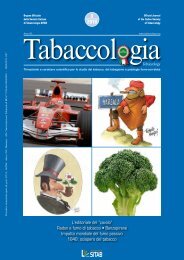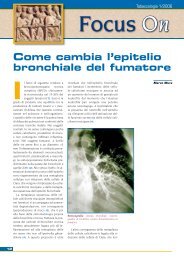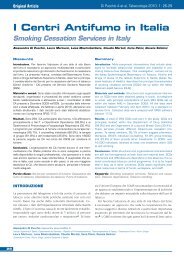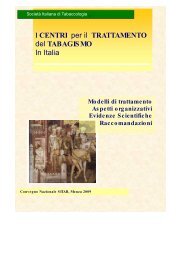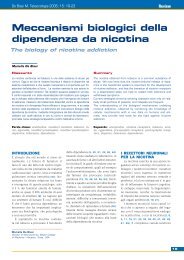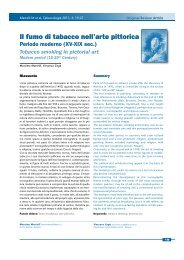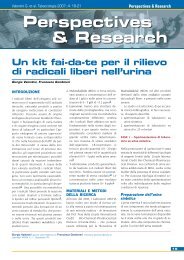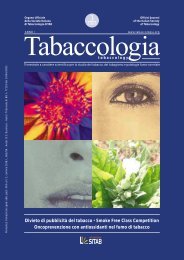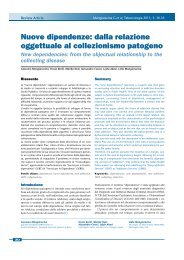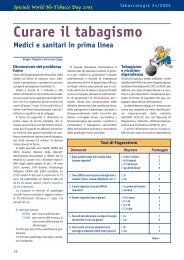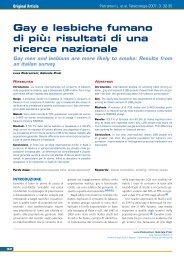Scarica n. 1/2011 - Società Italiana di Tabaccologia
Scarica n. 1/2011 - Società Italiana di Tabaccologia
Scarica n. 1/2011 - Società Italiana di Tabaccologia
Create successful ePaper yourself
Turn your PDF publications into a flip-book with our unique Google optimized e-Paper software.
18<br />
Original Article Research<br />
te accettato, per un certo periodo, che l’esposizione alle<br />
ra<strong>di</strong>azioni da parte dei derivati del radon fosse la causa<br />
principale dell’elevato rischio <strong>di</strong> tumore nei lavoratori<br />
delle miniere <strong>di</strong> uranio, per cui Martel ne dedusse che la<br />
ra<strong>di</strong>oattività potesse rappresentare l’agente carginogeno<br />
nei fumatori. La sua conclusione fu che, data l’esposizione<br />
cronica a basse dosi concentrate in particolari aree del<br />
polmone, il polonio-210 fosse probabilmente la causa primaria<br />
del cancro del polmone, e forse, come suggerì in un<br />
documento successivo, anche <strong>di</strong> altri tipi <strong>di</strong> tumore [13].<br />
Confrontando la situazione dei fumatori e quella quei<br />
minatori già ricordati, Martell stabilì che il rischio non<br />
proveniene da un’alta ra<strong>di</strong>oesposizione in un lasso <strong>di</strong> tempo<br />
ben determinato, ma piuttosto da quella a basse dosi,<br />
prolungata nel tempo. Il fumatore si rifornisce <strong>di</strong> polonio<br />
con ogni tirata <strong>di</strong> sigaretta, per cui l’alta quantità cumulativa<br />
<strong>di</strong> ra<strong>di</strong>azioni associata a una vita <strong>di</strong> fumo porterebbe a<br />
un alto rischio <strong>di</strong> cancro malgrado la relativamente bassa<br />
quantità <strong>di</strong> polonio-210 contenuta in ogni singola sigaretta.<br />
Nel 1974, dopo un esperimento <strong>di</strong> introduzione forzata<br />
<strong>di</strong> polonio nella trachea <strong>di</strong> criceto, Jack Little e, il suo collega<br />
<strong>di</strong> Harvard, William O’Toole riuscirono a confermare<br />
l’ipotesi che anche dosi estremamente limitate <strong>di</strong> polonio<br />
potessero provocare un tumore: infatti, il 94% dei criceti<br />
nel braccio sottoposto ad alta esposizione svilupparono<br />
tumori polmonari a dosi così basse che non davano segni<br />
<strong>di</strong> infiammazione [14]. 4<br />
La scienza “ombra”<br />
La Legacy Tobacco Documents Library è un archivio on-line<br />
<strong>di</strong> documenti interni dell’industria del tabacco, che furono<br />
desecretati e messi a <strong>di</strong>sposizione in seguito a proce<strong>di</strong>menti<br />
legali. Essi includono memorandum, appunti <strong>di</strong> incontri,<br />
corrispondenza e note varie. Questo unico e vasto archivio<br />
viene curato dalla University of California <strong>di</strong> San Francisco<br />
e contiene più <strong>di</strong> 60 milioni <strong>di</strong> pagine <strong>di</strong> documenti delle<br />
industrie del tabacco, che è possibile consultare per tipo <strong>di</strong><br />
argomento, società, e utilizzando qualsiasi parola o frase a<br />
propria scelta. Nel 2007 erano presenti 10.000 voci usando<br />
la parola-chiave “polonium”, e 64.000 usando”ra<strong>di</strong>ation”.<br />
Nel Maggio 2010, essendo stati aggiunti nel database altri<br />
documenti, tali numeri sono lievitati alle cifre, rispettivamente,<br />
<strong>di</strong> 15.000 e 100.000.<br />
La storia del polonio è lunga e complessa, e la ricerca<br />
<strong>di</strong> documenti me<strong>di</strong>ante parole-chiave come “polonium” o<br />
“210Po” hanno permesso <strong>di</strong> ricostruire la storia dettagliata<br />
della risposta, da parte delle case produttrici del tabacco, ai<br />
risultati della ricerca esterna sull’argomento. 5<br />
Come rivela la quantità spesso straripante <strong>di</strong> documenti,<br />
l’argomento polonio è stato ampiamente <strong>di</strong>scusso<br />
( 4) Per un’eccellente ed estensiva revisione della ricerca sul polonio nelle<br />
sigarette, ve<strong>di</strong> riferimento [15].<br />
( 5) I documenti sono consultabili online sul sito http://legacy.library.<br />
ucsf.edu.<br />
Rego B, <strong>Tabaccologia</strong> <strong>2011</strong>; 1: 15-22<br />
that ra<strong>di</strong>ation should also be accepted as the agent of<br />
cancer in smokers. He concluded that, given the chronic<br />
exposure to low doses concentrated in specific areas of<br />
the lungs, polonium-210 was likely the primary cause of<br />
lung cancer in smokers, and perhaps – as he suggested in<br />
a later paper – other types of cancer as well [13] [13].<br />
Comparing the ra<strong>di</strong>ation exposure of smokers to uranium<br />
miners, Martell stated that the danger came not<br />
with a high dose at any given time but, rather, with<br />
continued exposure to small doses over an extended<br />
period of time. A smoker replenishes his or her supply<br />
of polonium with each puff, therefore the high exposure<br />
associated with a lifetime of smoking would leave<br />
the smoker at a high risk for cancer despite the relatively<br />
low dose of polonium-210 per cigarette. In 1974,<br />
after forcing polonium into the tracheas of hamsters,<br />
Jack Little and fellow Harvard scientist William O’Toole<br />
were able to confirm the hypothesis that extremely low<br />
doses of polonium could cause cancer: 94 percent of<br />
hamsters in the highest exposure group developed lung<br />
tumors with doses so small that there was no inflammation<br />
[14] [14]. 4<br />
shadow science<br />
The Legacy Tobacco Documents Library is an online<br />
archive of internal tobacco industry papers that were<br />
released through litigation. These documents include<br />
memoranda, meeting minutes, correspondence, and<br />
notes. This vast, unparalleled archive is maintained<br />
through the University of California at San Francisco<br />
and boasts more than 60 million pages of industry documents,<br />
all of which can be searched by collection, company,<br />
and any word or phrase of one’s own choosing. In<br />
2007, there were about 10,000 keyword-search results for<br />
“polonium” and 64,000 results for “ra<strong>di</strong>ation.” In May<br />
2010, as documents have been added to the database,<br />
those numbers have swollen to more than 15,000 and<br />
nearly 100,000 respectively. The history of polonium in<br />
tobacco is clearly an extensive and complex story and<br />
systematic and continual searches through the documents<br />
for the names of key personnel and such keywords<br />
as “polonium” or “210Po” have allowed the reconstruction<br />
of a detailed history of the tobacco industry’s response<br />
to external research on the polonium issue. 5<br />
As the often-overwhelming quantity of documents reveals,<br />
polonium has been a widely <strong>di</strong>scussed issue within<br />
the industry. Perhaps even more impressive is the range<br />
of tobacco men involved in the <strong>di</strong>scussions. In one company<br />
alone, the list of people carbon-copied on many<br />
Philip Morris memoranda concerning polonium include<br />
scientists and researchers <strong>di</strong>rectly involved in ra<strong>di</strong>o-<br />
( 4) For an excellent and extensive review of scientific research on polonium<br />
in cigarettes, see cit. [15] [15].<br />
( 5) The documents are online and open to the public at http://legacy.<br />
library.ucsf.edu.



